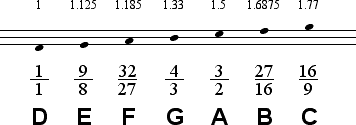
How are letters assigned to the natural tones? Historically, this is a complicated matter, but we can use a simple novel approach. Recall that we began with one string sounding its entire length, and we called this the source, from which all other tones are derived. Considering this source tone at length can inspire some bad poetry. Specifically, the source tone is like a river which opens up into a tonal sea. This touching concept provides a useful bridge between tones and letters. The point at which a river opens up into the sea is called a delta, because of its triangular shape which is like the Greek letter delta Δ.

Delta Δ is the fourth letter of the Greek alphabet, which corresponds to the letter D in the Latin alphabet. As the source tone is like the river opening up into a sea of tonal possibilities, so the source tone is called delta, D.

Ah, poetry. With the source tone labeled D, we consider what the first new tone in the system should be labeled. The first new tone, 3/2, can be designated by the first letter of the Latin alphabet A.

From these two letters, the letters designating the remaining tones simply fall into place. This can be shown on the number line. First, we place the letters A and D under the corresponding tones.


Next, we simply fill in the alphabet staring with A and continuing up to D.


Finally, we fill in the alphabet staring with D on the left, continuing to the last remaining tone, G.


The seven letters, A through G, which stand for these seven tones, are called natural letters, or also simply naturals. For most people, the letter names are easier to remember than the ratio values for each tone, but it is important to remember that the numbers organize the tones. The organization shown above is known as the Dorian mode, which should be easy to remember since Dorian begins with the letter D. Below, these letters are rearranged in order according to how the system is derived.

The pattern of letters shown above represents the basic organization of tones in Western music. Musicians should memorize this order of letters from left to right and also from right to left.
Thus far, tones have been displayed on number lines as exact distances on a horizontal axis. In contrast, conventional Western staff notation uses a vertical axis to provide positions for naturals only. The horizontal axis is used to show duration. A staff is a group of equally spaced horizontal lines which provide natural positions for notes which represent tones. One line offers three possible natural positions.

Our tone system has more than three naturals, so we need more lines. Two lines offer five possible positions.

We still need more lines. Three lines offer seven possible positions.

This is the minimum number of lines needed for our system, since there are seven naturals. First, we transfer the values of the tones in ascending order from our previous charts to notes on the staff.




Next, we add the letter names below the notes.

Just as the seven letters, A through G, which stand for these seven pitches, are called naturals, so the notes which represent these seven tones are called natural notes. Notice that successive staff positions represent successive steps between the naturals. It is important to note that although the distances between steps appear to be equal on the staff, these distances are in fact unequal, as has been shown on the number line. We are coming close to a representation of a so-called natural scale, but before completing a scale, we should get a feel for working with letters only, without the numbers. For this purpose, clefs are established.
Clefs are simply a way of designating a line as either G, F, or C. One of the staff lines is marked by a letter in the staff itself. For example, the middle line is marked G.

This is known as the G clef or treble clef. If we add two lines above the three existing lines, we arrive at a modern five line staff. The added lines allow us to include a duplicate of the source tone to show a complete scale. The modern treble clef symbol is actually a stylized G which designates the second staff line as a position called G.


In another arrangement, the middle line is designated as F.

This is known as the F clef or bass clef. If we add two lines below the three existing lines, we arrive at a modern five line staff, allowing us to include a duplication of the lowest tone to show a complete scale. The modern bass clef symbol is actually a stylized F which designates the fourth staff line as a position called F.


In between these two staves we find the note C.

The C clef is actually a stylized letter C which designates a line as the position C.


Each tone is given a number designating its place within a diatonic scale. These are called scale degrees, and are indicated by numbers topped with a carats.


Notice that the tonic is the 1st degree regardless of whether it is in the first position or eighth position. The number 8 is sometimes used for tonic in the latter position, but this should be avoided, as it encourages the misconception that there are 8 natural tones, which is clearly false.
We have applied seven letter names to the seven natural diatonic tones, and used five staff lines and a clef to notate these seven tones. This is the system of naturals, as summarized in the figures below.






Although working with notes and letters only has a certain elegance, it is also deceptively difficult to do effectively without a thorough understanding of intervals, which may be understood by studying the diatonic modes. Before proceeding to this topic, you may wish to read through this text again beginning with 3 Tones.
NEXT: Chapter 2 · Intervals